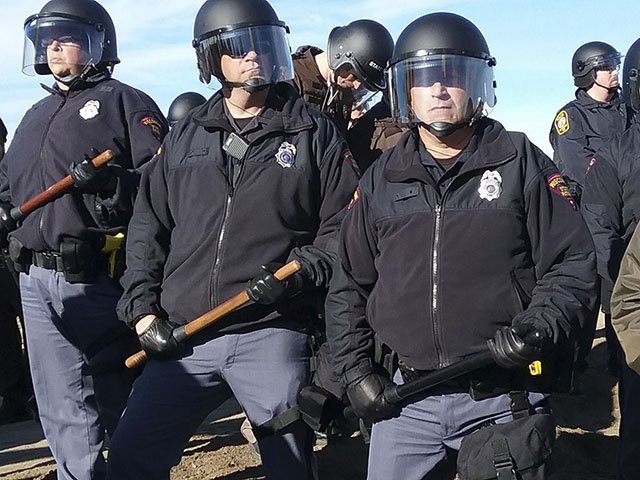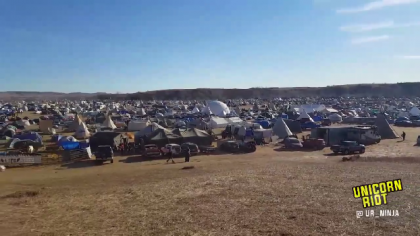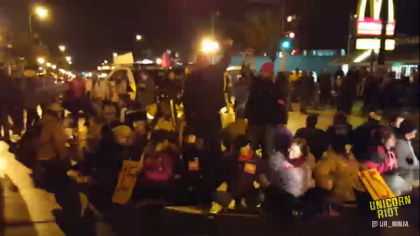Documents Show Details of Wisconsin EMAC Assistance to Morton County Sheriff
Morton County, ND – In August, North Dakota Governor Jack Dalrymple declared a State of Emergency in reaction to ongoing direct actions and demonstrations against construction of the Dakota Access Pipeline (DAPL) in Morton County, near the Standing Rock Sioux Tribal reservation.
Dalrymple’s State of Emergency enabled North Dakota law enforcement, specifically the Morton County Sheriff’s Department assisted by the state’s Department of Emergency Services, to take advantage of a program passed 20 years ago under the Bill Clinton presidency, the Emergency Management Assistance Compact (each participating state has a corresponding implementation statute).
“The Emergency Management Assistance Compact (EMAC) authorized states to enter into agreements with other states in order to share emergency management–related personnel during crisis situations. One of the only other times this compact was deployed outside of a natural disaster was for the Black Lives Matter protests in Baltimore after the death of Freddie Gray…According to a history of EMAC published in September 2014, the compact centers around empowering states to respond to massive hurricanes, and in particular, Hurricane Andrew, which caused nearly $25 billion in damages when it hit Florida and Louisiana in 1992…More recently, states used EMAC to work together during both Hurricane Sandy in 2012 and Hurricane Matthew in 2016. All 50 states, plus the District of Columbia, Puerto Rico, Guam, and the U.S. Virgin Islands, participate in EMAC. With language mostly centering around natural disaster relief, the congressional joint resolution creating EMAC also notes it exists to help manage things like “community disorders, insurgency, or [an] enemy attack.” – DeSmogBlog, This Natural Disaster Assistance Law is Why Other States Are Policing Dakota Access Pipeline Protests
Wisconsin was one nearby state that sent officers from several departments. An “EMAC Response After-Action Report“ created by the Wisconsin State Patrol (WSP), acquired by Melissa Hill through a records request made using Muckrock.com, shows some details of their deployment.
The report states that Wisconsin provided a “mobile field force” of 17 state troopers, with additional personnel from the Dane, St. Croix, Marathon, and Rock County Sheriff’s Departments, in a detail lasting from October 9 until October 15, 2016. Two Wisconsin state troopers also served as a “Force Protection Team“, also called the “Less Lethal team“, on October 10 (Indigenous People’s Day/Columbus Day) when 27 people were arrested on or near a DAPL work site in Morton County, ND.
Among those arrested on October 10 was Rebecca Kemble, a Madison, Wisconsin alderwoman, who was present acting as a legal observer. Madison attorney Patricia Hammel, was also present in Morton County on October 10 but was not arrested. Hammel told the Wisconsin’s Isthmus what she observed after water protectors began their prayer ceremony at the pipeline site:
“Within an hour, about 50 law enforcement officers arrived and came marching up the highway…I was amazed to see that most of them were from Wisconsin.” – Patricia Hammel, Attorney

The Wisconsin State Patrol’s After-Action Report from their North Dakota deployment also includes “Suggested Improvements for Future Deployments“, such as: using cell phones instead of radios, donning Kevlar vests and riot helmets, using drones for “gathering intelligence“, as well as increasing the training of officers for “cut teams” to disable lockbox devices used by protesters.
Read the Wisconsin State Patrol EMAC Response After-Action Report, acquired by Melissa Hill (@smilyus on twitter) below, or you can download the .PDF at the Muckrock request page.
Unicorn Riot acquired a copy of the EMAC agreement used to send law enforcement from Wisconsin to North Dakota through a records request to the Marathon County Sheriff, who deployed deputies to Morton County alongside other Wisconsin agencies, The agreement is signed between Marathon County Sheriff Scott Parks and Brian Satula, administrator of Wisconsin’s Division of Emergency Management (WEM).
We also acquired a nearly identical EMAC agreement document that the St. Croix County Sheriff’s Department signed with WEM. These documents show that Wisconsin’s Division of Emergency Management coordinated with North Dakota’s Department of Emergency Services to send deputies from Dane, St. Croix, Marathon, and Rock counties to Morton County for DAPL operations.
The maximum cost to to be incurred by Marathon County and reimbursed by Morton County is listed as $48,000. The agreement also states that:
“EMAC has been implemented to assist the State(s) or Province(s) of Morton County, North Dakota to respond to pipeline protests .” – pg. 5 Wisconsin EMAC Agreement
The “customary hours” under an EMAC agreement are listed as 12 hours which “may be in sub-standard conditions“, while the deputies would be compensated at the same rate as they would at home. The “Liability” section of the agreement states that:
“Officers or employees of a member state or province, as well as officers of a local, municipal, county, state, and/or non-state entity rendering aid in another state or province pursuant to this Agreement shall be considered agents of the requesting state/province for tort liability and immunity purposes.” – pg. 7 Wisconsin EMAC Agreement
In the event any out-of-state law enforcement officers commit acts that lead to a lawsuit being filed, the out-of-state agency which provided the personnel in question would most likely be able to deflect the liability onto Morton County and North Dakota.
Officers who have been involved in policing #NoDAPL have not been wearing nameplates or badge numbers that could be used to identify them, making it harder for individual officers to be held accountable. The Wisconsin State Patrol’s After Action report makes it official that obfuscation and anonymization is an explicit strategy circulating in law enforcement circles, and not an oversight: “Remove the name tag from the Class uniform and replace it with a ‘call or badge’ number.”
Read the EMAC Agreement documents below: EMAC Agreement 1 (PDF)
emac-request-1emac-request-2
An EMAC R-2 form from the St. Croix County Sheriffs office shows some of the expenses incurred by Morton County to repay for assistance from Wisconsin.
201612020901-1
Unicorn Riot’s research continues into the Emergency Management Assistance Compact, and federally supported joint law enforcement programs such as FEMA’s Field Force Operations training doctrine, which we published November 16th. Please send similar documents to [email protected]. On November 1st we reported on large protests against the deployment of Hennepin County Sheriffs Office personnel from Minneapolis to DAPL, with the approval of the state’s emergency management authorities.
Unicorn Riot will continue to regularly provide direct updates about resistance to the Dakota Access Pipeline. Follow our media on Twitter, Facebook, and our website for more information.
To help our volunteer-operated, horizontally-organized, non-profit media collective please consider a tax-deductible donation:
Below is Unicorn Riot’s coverage of the [#NoDAPL] anti-Dakota Access Pipeline struggle from early summer 2016 to present:
March – May 2016
- March 29th, “Tribal Citizens Prepare to Blockade Bakken Oil Pipeline“.
- April 3rd, “Tribal Citizens Build Camp in Path of Oil Pipeline“.
- May 5th, “Sacred Stone Camp Resists Dakota Access Pipeline“.
- May 27th, “Dakota Access Pipeline Blockade Enters 2nd Month“.
August 2016
- After covering the camp in the spring of 2016, Unicorn Riot returned to Standing Rock Reservation on Wednesday, August 10th, when Standing Rock tribal members and allies blocked the entrance to the Dakota Access Pipeline construction site.
- On Thursday, August 11th, a dozen or so people were arrested blocking the construction site entrances.
- Day 3, Friday, the fight to protect land & water intensified around the construction sites of the Dakota Access Pipeline.
- On the 4th day, the pipeline resistance encampment swelled and prepared for more action.
- Monday, August 15th, land defenders stormed the construction site halting construction, and the next day construction was halted as well.
- August 17th saw State Police begin checkpoints, roadblocks, and psyops as protesters united to defend water.
- August 24th, camps prepared as Federal injunction hearing looms.
- Camps Organize to Stay as Injunction Postponed.
- On August 31st, Non-Violent Direct Action Stopped DAPL Construction for Over 6 Hours.
September 2016
- September 6, indigenous water protectors swarmed Dakota Access Pipeline site, stopped work
- September 7, Uŋpa Nuŋpa was interviewed about ongoing #noDAPL actions
- North Dakota highway patrol refused to release email correspondence with Energy Transfer Partners
- September 8, ND National Guard took over Dakota Access Pipeline checkpoints
- Friday, September 9, US Govt. overruled federal judge and requested pipeline construction halted at Lake Oahe
- Meanwhile, cultural activities continued at #NoDAPL camps despite more arrests/warrants
- September 13, 20 were arrested during #NoDAPL lockdown, including 2 Unicorn Riot journalists
- September 14, direct actions continued against Dakota Access Pipeline while legal repression intensified
- On September 16 a federal judge dissolved the unconstitutional temporary restraining order Dakota Access, LLC had filed against Stranding Rock tribal members
- September 19, as solidarity protests spread nationwide, the federal appeals court ordered construction temporarily stop on Dakota Access segment as Solidarity Protests Spread Nationwide
- September 21, #NoDAPL noise demo demanded freedom for jailed water protector Olowan Martinez
- September 22, water protectors disrupted the annual meeting of the North Dakota Petroleum Council
- September 25, water protectors planted trees on DAPL construction site
- In Iowa on September 26, a non-violent direct action from the Mississippi Stand camp stopped DAPL construction for the day
- September 26, a caravan of water protectors stopped work at DAPL site
- September 27, militarized police arrested 23 water protectors in DAPL work stoppage
- September 29, a #NoDAPL solidarity action took place at MN Enbridge office
October 2016
- October 3rd-4th saw the “Toxic Tour,” Governor debate disruption, and water protectors attend their court arraignment
- October 4, we learned North Dakota Governor Dalrymple’s email inbox was full of support for #NoDAPL
- October 5, Buffer Zone Holds as Caravans Continue to Disrupt DAPL – New Felony Charges
- October 7, 6 Arrested in Iowa #NoDAPL Action, Including Unicorn Riot Journalist
- October 8, Iowa Water Protectors Blockade DAPL Drill Site Twice in 24 Hours
- October 9, Federal Appeals Court Rules to Allow DAPL Construction
- October 10, 27 Arrests After Water Protectors Pray at DAPL Site on Indigenous People’s Day
- October 12, Lockdown Stops DAPL Construction in Iowa, 3 Arrested, Including Unicorn Riot Journalist
- October 14, Emails Show North Dakota Budget Bureaucracy Behind #NoDAPL Policing
- October 16, Direct Actions Continue to Stop DAPL Construction in Iowa and North Dakota
- October 17, Four Unicorn Riot Journalists Face Charges For Covering #NoDAPL
- October 17, Water Protectors Blockade Highway in Bismarck, Some Charges Dropped
- October 20, As DAPL Construction Advances, Water Protectors Continue Direct Action
- October 22, Water Protectors’ Prayer Walk Ends up with 127 Arrests, Including Unicorn Riot Journalist
- October 23, Law Enforcement Attack Private Drone as Water Protectors Erect Blockade & New Winter Camp
- October 24, Mississippi Stand Blockades Iowa DAPL Drill Waste Site, Drilling Stops
- October 25, Records Release: Morton County’s Law Enforcement Mutual Aid Assistance Agreement
- Hundreds Flood Minneapolis City Hall to Demand Local Sheriff Withdraw from North Dakota
- October 26, Tensions Rise as Pipeline Construction Nears #NoDAPL Blockade
- October 27, Police and Military Attack Oceti Sakowin Treaty Camp
November 2016
- November 1, #NoDAPL Solidarity Rally & Sit-In in Minneapolis Prods Sheriff into Removing Deputies
- November 1, DAPL Resistance Continues Despite Advancing Construction
- November 2, Police Attack Water Protectors Defending Sacred Sites
- November 5, DAPL Construction Nears US Army Corps Land While Still Lacking Permits
- November 6, Water Protectors Attempt to Reclaim Sacred Burial Site, Demonstrate in Cemetery
- November 8, Dakota Access Announces Plan to Drill Under Missouri River Within Weeks
- November 11, Dakota Access Pipeline Work Stopped As Water Protectors Storm Site; 30+ Arrested
- November 14, #NoDAPL Water Protectors March on ND State Capitol after Caravan Disrupts Construction
- November 14, Mississippi Stand Goes Inside Pipeline and Shuts Down DAPL Construction
- November 14, Army Corps Delays DAPL Easement
- November 15, “No More Stolen Sisters” Demonstration Blockades DAPL Man Camp; 25+ Arrests
- November 16, Despite Army Corps Statement, DAPL Moves Horizontal Drill to Missouri River Crossing
- November 17, Demonstration in Bismarck-Mandan, Cass County Deputies Beat Man Bloody
- November 20, Police Attack Unarmed Water Protectors w/ Rubber Bullets, Tear Gas, and Water Cannons; 300+ injured
- November 21, Land Defense & Water Protection Actions Ripple Across Turtle Island
- November 22, Hundreds Target U.S. Army Corps Building in St. Paul w #NoDAPL Message
- November 22, Anonymous DDOS Munitions Vendor After Sheriffs Attack #NoDAPL
- November 22, #NoDAPL Water Protector Faces Possible Loss Of Her Arm After Police Attack
- November 24, Water Protectors Bridge onto Turtle Island; Mandan Thanksgiving Street Feast
- November 25, U.S. Army Corps of Engineers Announces Intent to Close Oceti Sakowin #NoDAPL Camp



